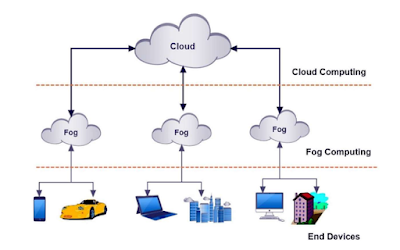Fog computing
The term fog computing (or fogging) was
coined by Cisco in 2014, so it is new for the general public. Fog and cloud
computing are interconnected. In nature, fog is closer to the earth than
clouds; in the technological world, it is just the same, fog is closer to
end-users, bringing cloud capabilities down to the ground.
The main difference between fog
computing and cloud computing is that cloud is a centralized system, while the
fog is a distributed decentralized infrastructure.
 |
Impact of current Cloud Computing
technologies on IoT based devices.
|
Innovations in services applications
are transforming industry in profound ways, enabling information and computing
tech to perform business services more efficiently. It also involves building
autonomous infrastructures that require minimal human involvement.
One of the most underappreciated
aspects of this technology is how all of these massive applications must work
together. Cutting-edge developments in cloud, edge, and Internet-of-Things
(IoT) systems, as well as intelligent computing, deep learning, big data, and
blockchain are already impressive enough. However, effectively managing how to
integrate these massive and sophisticated technologies requires a knowledge
base wider than any one department or company.
 |
source : https://ieeexplore.ieee.org
|
Both cloud computing and fog computing
provide storage, applications, and data to end-users. However, fog computing
has a closer proximity to end-users and bigger geographical distribution.
Reduced data transfer latency, Fast access to the faulty areas and Quick
functional recovery and self-healing capabilities that brings resilience in the
system.
‘Cloud computing’ is the practice of using a
network of remote servers hosted on the Internet to store, manage, and process
data, rather than a local server or a personal computer. Cloud computing can be
a heavyweight and dense form of computing power.
Fog computing or fog networking, also
known as fogging, is an architecture that uses edge devices to carry out a
substantial amount of computation, storage, communication locally and routed
over the internet backbone.
An edge device is a device which
provides an entry point into enterprise or service provider core networks.
Examples include routers, routing switches, integrated access devices (IADs),
multiplexers, and a variety of metropolitan area network (MAN) and wide area
network (WAN) access devices. Edge devices also provide connections into
carrier and service provider networks. An edge device that connects a local
area network to a high speed switch or backbone (such as an ATM switch) may be
called an edge concentrator.
In general, edge devices are normally
routers that provide authenticated access (most commonly PPPoA and PPPoE) to
faster, more efficient backbone and core networks. The trend is to make the
edge device smart and the core device(s) "dumb and fast", so edge
routers often include Quality of Service (QoS) and multi-service functions to
manage different types of traffic. Consequently, core networks are often
designed with switches that use routing protocols such as Open Shortest Path
First (OSPF) or Multiprotocol Label Switching (MPLS) for reliability and
scalability, allowing edge routers to have redundant links to the core network.
Links between core networks are different, for example Border Gateway Protocol
(BGP) routers often used for peering exchanges.
 |
source : https://ieeexplore.ieee.org
|
In conclusion, IoT gateways drivers
will address Fog Computing in these areas.
-
Role of IoT gateway edge analytics in data processing & management.
-
How distributed edge analytics works in larger geographical areas.
-
How fog computing works with smart grids for faster data processing.
No comments:
Post a Comment